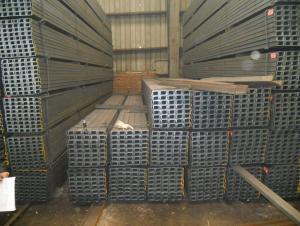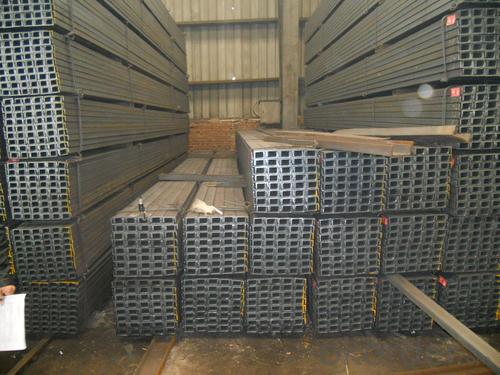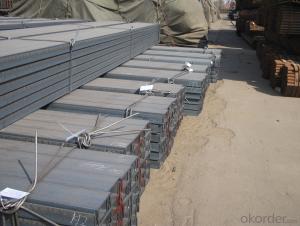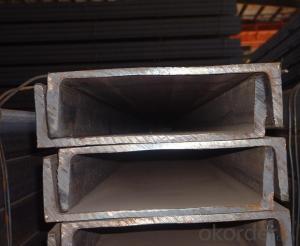Prime Hot Rolled Steel U Channel GB Standard
- Loading Port:
- China main port
- Payment Terms:
- TT OR LC
- Min Order Qty:
- 100 m.t.
- Supply Capability:
- 10000 m.t./month
OKorder Service Pledge
OKorder Financial Service
You Might Also Like
Product Description:
OKorder is offering Prime Hot Rolled Steel U Channel GB Standard at great prices with worldwide shipping. Our supplier is a world-class manufacturer of steel, with our products utilized the world over. OKorder annually supplies products to African, South American and Asian markets. We provide quotations within 24 hours of receiving an inquiry and guarantee competitive prices.
Product Applications:
Prime Hot Rolled Steel U Channel GB Standard are ideal for structural applications and are widely used in the construction of buildings and bridges, and the manufacturing, petrochemical, and transportation industries.
Product Advantages:
OKorder's Prime Hot Rolled Steel U Channel GB Standard are durable, strong, and wide variety of sizes.
Main Product Features:
· Premium quality
· Prompt delivery & seaworthy packing (30 days after receiving deposit)
· Can be recycled and reused
· Mill test certification
· Professional Service
· Competitive pricing
Product Specifications:
Manufacture: Hot rolled
Grade: Q195 – 235
Certificates: ISO, SGS, BV, CIQ
Length: 6m – 12m, as per customer request
Packaging: Export packing, nude packing, bundled
| GB STANDARD CHANNEL | ||||||
| SIZE(MM) | h(mm) | b(mm) | s(mm) | t(mm) | kg/m | length |
| 50X37x4.5x7 | 50 | 37 | 4.5 | 7 | 5.438 | 6m,12m |
| 63X40x4.8x7.5 | 63 | 40 | 4.8 | 7.5 | 6.634 | 6m,12m |
| 80x43x5x8 | 80 | 43 | 5 | 8 | 8.045 | 6m,12m |
| 100x48x5.3x8.5 | 100 | 48 | 5.3 | 8.5 | 10.007 | 6m,12m |
| 120x53x5.5x9 | 120 | 53 | 5.5 | 9 | 12.059 | 6m,12m |
| 140x58x6x9.5 | 140 | 58 | 6 | 9.5 | 14.535 | 6m,12m |
| 140x60x8x9.5 | 140 | 60 | 8 | 9.5 | 16.733 | 6m,12m |
| 160x63x6.5x10 | 160 | 63 | 6.5 | 10 | 17.24 | 6m,12m |
| 160x65x8.5x10 | 160 | 65 | 8.5 | 10 | 19.752 | 6m,12m |
| 180x68x7x10.5 | 180 | 68 | 7 | 10.5 | 20.174 | 6m,12m |
| 180x70x9x10.5 | 180 | 70 | 9 | 10.5 | 23 | 6m,12m |
| 200x73x7x11 | 200 | 73 | 7 | 11 | 22.637 | 6m,12m |
| 200x75x9x11 | 200 | 75 | 9 | 11 | 25.777 | 6m,12m |
| 220x77x7x11.5 | 220 | 77 | 7 | 11.5 | 24.999 | 6m,12m |
| 220x79x9x11.5 | 220 | 79 | 9 | 11.5 | 28.453 | 6m,12m |
| 250x78x7x12 | 250 | 78 | 7 | 12 | 27.41 | 6m,12m |
| 250x80x9x12 | 250 | 80 | 9 | 12 | 31.335 | 6m,12m |
| 250x82x11x12 | 250 | 82 | 11 | 12 | 35.26 | 6m,12m |
| 280x82x7.5x12.5 | 280 | 82 | 7.5 | 12.5 | 31.427 | 6m,12m |
| 280x84x9.5x12.5 | 280 | 84 | 9.5 | 12.5 | 35.823 | 6m,12m |
| 280x86x11.5x12.5 | 280 | 86 | 11.5 | 12.5 | 40.219 | 6m,12m |
| 300x85x7.5x13.5 | 300 | 85 | 7.5 | 13.5 | 34.463 | 6m,12m |
| 300x87x9.5x13.5 | 300 | 87 | 9.5 | 13.5 | 39.173 | 6m,12m |
| 300x89x11.5x13.5 | 300 | 89 | 11.5 | 13.5 | 43.883 | 6m,12m |
FAQ:
Q1: How do we guarantee the quality of our products?
A1: We have established an advanced quality management system which conducts strict quality tests at every step, from raw materials to the final product. At the same time, we provide extensive follow-up service assurances as required.
Q2: How soon can we receive the product after purchase?
A2: Within three days of placing an order, we will arrange production. The normal sizes with the normal grade can be produced within one month. The specific shipping date is dependent upon international and government factors, the delivery to international main port about 45-60days.
Q3: How many tons of steel products could be loaded in containers?
A3: Usually the steel products are delivered by bulk vessel because of the large quantity and the freight. However, there are no bulk vessel enter some seaports so that we have to deliver the cargo by containers. The 6m steel product can be loaded in 20FT container, but the quantity is changed according to the size, usually from 18tons to 25tons.
Images:


- Q: Can steel channels be used in data center construction?
- Data center construction can indeed utilize steel channels. These channels are frequently employed in construction due to their strength, durability, and versatility. When it comes to data center construction, steel channels have a variety of applications. They can serve as framing and support structures for raised floors, server racks, cable trays, and equipment mounts. By offering a robust and stable framework, they are capable of withstanding hefty loads and ensuring the data center's structural integrity. Furthermore, steel channels can assist with cable management, allowing for the organized routing and protection of data and power cables throughout the facility. All in all, steel channels are a dependable and extensively used component in data center construction owing to their structural properties and suitability for accommodating the intricate infrastructure requirements of modern data centers.
- Q: What are the factors that affect the price of steel channels?
- There are several factors that can impact the price of steel channels. 1. Raw material costs: The price of steel channels is heavily influenced by the cost of raw materials, particularly steel. Fluctuations in the price of iron ore, coal, and other materials used in steel production can directly affect the cost of manufacturing steel channels. 2. Supply and demand: The overall demand for steel channels in the market can impact their price. If demand is high and supply is limited, prices are likely to increase. Conversely, if demand is low and there is excess supply, prices may decrease. 3. Manufacturing and processing costs: The cost of producing steel channels, including labor, energy, and equipment expenses, can impact the final price. Higher manufacturing costs may lead to higher prices for steel channels. 4. Market competition: The level of competition among steel channel manufacturers can also influence prices. When there are multiple producers offering similar products, they may engage in price competition to attract customers, resulting in lower prices. Conversely, if there are fewer suppliers or if they have a unique product, prices may be higher. 5. Transportation and logistics: The cost of transporting steel channels from manufacturing facilities to distribution centers or end-users can impact the final price. Factors such as fuel prices, shipping distances, and transportation infrastructure can all affect transportation costs, which may be passed on to the buyer. 6. Government regulations and tariffs: Trade policies, import duties, and government regulations can also affect the price of steel channels. Tariffs imposed on imported steel channels can increase their price, while government subsidies or support can lead to lower prices. 7. Economic conditions: Overall economic conditions, both globally and domestically, can have an impact on steel channel prices. Factors such as economic growth, inflation, and currency exchange rates can all influence the cost of steel channels. It is important to note that these factors are interrelated and can vary depending on the specific market dynamics and location. Therefore, understanding these factors and their potential impact is crucial for buyers and sellers in the steel channel industry.
- Q: What are the advantages of using hot-rolled steel channels?
- Hot-rolled steel channels offer numerous benefits in various applications. To begin with, their structural integrity is exceptional. By heating the steel above its recrystallization temperature during the hot rolling process, a more uniform grain structure is achieved. As a result, the material becomes stronger and more durable, capable of withstanding heavy loads and high stress levels. Moreover, hot-rolled steel channels come in a wide range of sizes and shapes, making them versatile for different construction projects. With various dimensions available, including different heights, widths, and thicknesses, these channels offer flexibility in design and application. Furthermore, hot-rolled steel channels are cost-effective. The efficiency and relatively low cost of the hot rolling process make them more affordable compared to other structural materials. This makes them an attractive option for projects with limited budgets. In addition, hot-rolled steel channels exhibit excellent workability. The hot rolling process enhances the ductility of the steel, making it easier to shape, cut, and weld. This allows for efficient fabrication and customization of the channels to meet specific project requirements. Lastly, hot-rolled steel channels have a high degree of recyclability. Steel is one of the most recycled materials worldwide, and hot-rolled steel channels can be easily recycled and repurposed without compromising their structural properties. This environmentally friendly characteristic contributes to sustainable construction practices. In conclusion, the advantages of hot-rolled steel channels include superior structural integrity, versatility in size and shape, cost-effectiveness, good workability, and recyclability. These advantages make hot-rolled steel channels a popular choice in industries such as construction, manufacturing, and infrastructure development.
- Q: How are steel channels used in the construction of warehouses?
- Due to their strength and versatility, steel channels find common usage in warehouse construction. Their primary function is to provide support and structural stability to the building. This is achieved by using them as beams or columns to evenly distribute heavy loads throughout the warehouse. Steel channels can withstand the weight of storage racks, equipment, and inventory, making them an indispensable component in warehouse construction. Aside from their role in structural support, steel channels also serve framing and bracing purposes. They help establish a framework for the building, allowing for the installation of walls, roofs, and other components. By doing so, steel channels ensure that the warehouse is capable of withstanding external forces such as wind and seismic loads. In addition, steel channels find application in constructing mezzanine floors within warehouses. These intermediate levels are commonly used for storage or office space and require sturdy and durable support. Steel channels provide the necessary strength and stability to ensure the safety and functionality of these additional levels. Furthermore, steel channels are frequently utilized in the construction of conveyor systems in warehouses. These systems facilitate the transportation of goods and materials throughout the facility. Steel channels provide a robust base for the conveyor belts, ensuring smooth and efficient movement of items. In summary, steel channels have a crucial role in warehouse construction, fulfilling functions such as providing structural support, framing, bracing, and support for mezzanine floors and conveyor systems. Their durability, strength, and versatility make them an ideal choice for warehouse construction, guaranteeing the safety, efficiency, and longevity of these structures.
- Q: Can steel channels be used in bridge construction?
- Yes, steel channels can be commonly used in bridge construction. Steel channels are structural components made of steel that have a C-shaped cross-section. They offer high strength, durability, and versatility, making them suitable for various applications in bridge construction. Steel channels are often used as beams or supports in bridge construction because of their ability to withstand heavy loads and provide structural stability. They can be used as primary load-bearing members or secondary components to support other bridge elements. The use of steel channels in bridge construction offers several advantages. Firstly, steel channels have excellent strength-to-weight ratio, meaning they can provide high load-carrying capacity while being relatively lightweight. This results in cost savings during construction and reduces the overall weight of the bridge, leading to more efficient designs. Secondly, steel channels are resistant to corrosion, which is crucial for bridges exposed to harsh environmental conditions, such as bridges built near saltwater or in areas with high humidity. Steel channels can be galvanized or coated with protective layers to enhance their resistance to corrosion, ensuring the longevity and durability of the bridge structure. Furthermore, steel channels can be easily fabricated and customized to meet specific design requirements. They can be cut, welded, and shaped into various lengths and sizes to fit the bridge design. This flexibility allows engineers to create complex bridge structures that are both strong and aesthetically pleasing. In conclusion, steel channels are a commonly used component in bridge construction due to their strength, durability, and versatility. They provide structural stability, high load-carrying capacity, resistance to corrosion, and cost-effective solutions for bridge designs.
- Q: Can steel channels be used for aesthetic purposes in architectural designs?
- Yes, steel channels can definitely be used for aesthetic purposes in architectural designs. Their sleek and modern appearance, along with their versatility and strength, make them a popular choice for contemporary and industrial-style buildings. Steel channels can be used as decorative elements, facades, or structural features, adding a visually appealing and unique touch to the overall design.
- Q: Can steel channels be used for creating support structures for ventilation systems?
- Support structures for ventilation systems can be created using steel channels. These channels are widely used in construction and engineering because of their durability and strength. They offer a solid framework for supporting the weight of ventilation equipment, including fans, filters, and ductwork. Moreover, steel channels provide design flexibility and can be tailored to meet specific project needs. Furthermore, steel is resistant to corrosion and can withstand harsh environmental conditions, making it suitable for use in moisture or chemical-exposed ventilation systems. Ultimately, steel channels are a dependable option for establishing support structures that guarantee the secure and effective functioning of ventilation systems.
- Q: How are steel channels classified based on their shape?
- Steel channels are classified based on their shape into three main categories: C channels, U channels, and miscellaneous channels. C channels, also known as C-shaped channels or simply channels, have a distinct shape resembling the letter "C". They have a flat vertical back and two horizontal flanges extending outward from the back. C channels are widely used in construction and structural applications, providing excellent load-bearing support. U channels, also referred to as U-shaped channels or simply U-channels, have a U-shaped cross-section with two vertical sides and a horizontal base. The two vertical sides are known as flanges, while the horizontal base is called the web. U channels are commonly employed in manufacturing and fabrication processes, offering stability and strength to various structures. Miscellaneous channels encompass all other steel channel shapes that do not fit into the C or U channel categories. These channels can have a range of shapes and sizes, including tapered flanges, uneven sides, or unique profiles. Miscellaneous channels are utilized in specialized applications where specific design requirements need to be met. In summary, steel channels are classified based on their shape into C channels, U channels, and miscellaneous channels, each serving different purposes in construction, manufacturing, and other industries.
- Q: Are steel channels suitable for marine applications?
- Steel channels are highly suitable for marine applications due to their strength and durability. They are crafted from a resilient material that is resistant to corrosion, making them an ideal choice for marine settings where saltwater exposure is constant. These channels are capable of enduring the harsh conditions of the ocean, including high levels of moisture, waves, and wind. Furthermore, they possess exceptional structural integrity and can provide support and stability for various marine structures like piers, docks, and offshore platforms. In addition to this, they are commonly employed in shipbuilding and the construction of marine vessels. All in all, steel channels offer a reliable and practical solution for marine applications as they possess the necessary strength, corrosion resistance, and ability to withstand the demanding conditions of the marine environment.
- Q: Can steel channels be used in renewable energy installations?
- Yes, steel channels can certainly be used in renewable energy installations. Steel channels are commonly used in construction and engineering projects due to their strength, durability, and versatility. In renewable energy installations, such as solar or wind power projects, steel channels can be used in various ways. For example, steel channels can be used to support and mount solar panels. They provide a stable and secure structure for the panels, ensuring that they are properly positioned to maximize sunlight absorption. Steel channels can also be used to create frames and mounting structures for wind turbines, providing a strong foundation for the blades and tower. Additionally, steel channels can be used in the construction of transmission and distribution infrastructure for renewable energy. They can be used to create support structures for power lines, ensuring the safe and reliable transmission of electricity generated from renewable sources. Furthermore, steel channels can be used in the manufacturing of various renewable energy equipment and components. They can be used to create frames, brackets, and other structural components for solar inverters, battery storage systems, and other renewable energy devices. Overall, steel channels offer a cost-effective and reliable solution for various applications in renewable energy installations. Their strength, durability, and versatility make them suitable for supporting, mounting, and constructing various renewable energy equipment and infrastructure.
Send your message to us
Prime Hot Rolled Steel U Channel GB Standard
- Loading Port:
- China main port
- Payment Terms:
- TT OR LC
- Min Order Qty:
- 100 m.t.
- Supply Capability:
- 10000 m.t./month
OKorder Service Pledge
OKorder Financial Service
Similar products
Hot products
Hot Searches
Related keywords




























